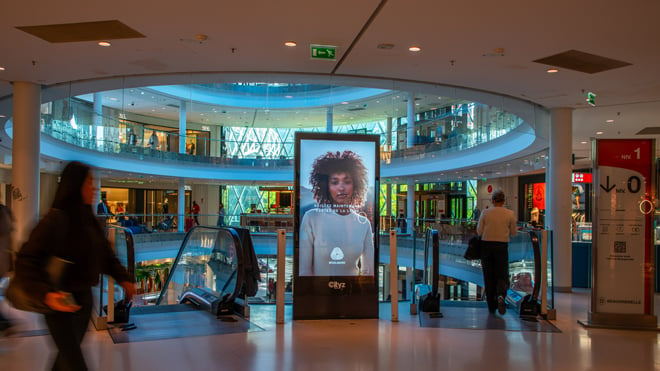‘Wear Wool, Not Waste’ marketing campaign

In September, Woolmark launched a powerful second chapter of its eco marketing campaign, highlighting to consumers that clothes made from synthetic fibres remain in the environment, damaging the planet, long after they have been discarded. The campaign urges consumers to consider the fibre composition of a clothing product – and choose wool – when they are thinking of making a purchase.
INTERIM CAMPAIGN RESULTS
(up to 14 November)
64.8 million
video views
241 million
impressions
865
media clippings
1.3 billion
media reach
Awarded
advert of the day in The Drum and Campaign UK and features in Famous Campaigns and Adweek
Building on the momentum and success of its ‘Wear Wool, Not Fossil Fuel’ marketing campaign which raised awareness of fossil fuel as the source of synthetic fibres, Woolmark has unveiled a new instalment in the campaign, titled ‘Wear Wool, Not Waste’, which highlights that synthetic apparel do not readily decompose and remain polluting the environment for centuries.
Importantly, the campaign also highlights that wool has unparalleled advantages due to it being natural, renewable, biodegradable and the most recycled apparel fibre – and therefore a solution to reducing the fashion industry’s impact on the planet.
“Every synthetic garment ever made still exists in some form, haunting our planet.”
- Key campaign message
The first synthetic clothing made from fossil fuel was introduced about 100 years ago. Their use has steadily increased to the extent that synthetic fibres, especially polyester, are now the dominant fibre used in clothing and they continue to have a high market growth rate.
However, synthetic fibres do not readily biodegrade. This means that the average polyester product is likely to survive in landfills for more than 200 years, leaching chemicals, shedding microfibres on our land and in our oceans, and releasing methane as it rots.
It is predicted that in just ten years’ time, unless there is a shift in apparel manufacturing and consumption, 73% of the entire clothing market will be made from synthetic fibres, which will remain polluting the environment for generations to come.
“Wool is natural, renewable, biodegradable, and the most recycled apparel fibre.”
- Key campaign message
In contrast, wool is made of a natural, biodegradable protein. When a wool product reaches its end-of-life and is disposed of, the wool fibre readily decomposes in soil, slowly releasing valuable nutrients and carbon back into the earth, acting like a fertiliser.
Wool therefore fits very well into a sustainable ‘circular’ model of textile production that minimises waste and pollution, while synthetic fibres are more aligned with an unsustainable ‘linear’ model of textile production associated with waste and pollution.

Screenshot from the campaign film showing the planet increasingly overun with discarded synthetic clothing.
AWI CEO John Roberts says Woolmark’s eco marketing campaign aims to raise awareness of the detrimental impact of synthetics on the environment and urges consumers to actively consider fabric impact when purchasing clothes and seek out natural fibres, such as wool.
“The ‘Wear Wool, Not Waste’ instalment of the campaign highlights that when a synthetic garment is ‘thrown away’, it never actually goes ‘away’. It remains in the environment for centuries in some form,” John said.
“Synthetic clothes will outlive our grandchildren which is why the fashion industry must prioritise natural, biodegradable fibres. The campaign is an urgent call to consumers and the fashion industry at large to re-evaluate fibre choices.
“Ultimately it aims to encourage people to wear wool as an alternative to synthetic clothing.”
Campaign reveals the ‘zombie invasion’ of discarded synthetics
Screenshots from the campaign film. The immense and overwhelming accumulation of discarded synthetic clothing on the planet (left) contrasts with wool which is presented as a natural solution to fashion’s environment issues (right).
The new campaign centres around a 60-second hero film showing people in a city rushing to escape a massive ‘zombie invasion’ of old synthetic clothes, representing synthetic apparel that has been discarded over time but still haunts the planet to this day.
At the end of the video, and in contrast to the ‘zombie invasion’, is a lady alongside sheep in a peaceful, green and pastoral setting, emphasising the natural attributes of the wool clothing she is wearing. The film ends with the ‘Wear Wool, Not Waste’ call to action highlighted on screen.
Roll out of the new campaign in key consumer markets
The campaign has been rolled out across the US, UK, France and Australia focused on high attention video environments to distribute the hero film, including cinema, YouTube and Connected TV i.e. delivered to a smart TV via a streaming service.
The roll out of the campaign also includes highly targeted street-level advertising in high foot traffic, retail locations in New York, London and Paris, plus during the screening on TV of the AFL and NRL grand finals in Australia, and local activations across the world.
An army of influencers has also been engaged to help amplify the campaign, targeting Gen Z and Millennial audiences to drive deeper engagement.
Examples of campaign advertising: on the London Underground, at Times Square in New York, Midtown Manhattan in New York and the Beaugrenelle shopping centre in Paris.
More information: www.woolmark.com/wear-wool
Woolmark’s broader eco marketing campaign
“Woolmark’s eco marketing campaign aims to help reverse the rise of fast fashion, which is dominated by synthetic fibres such as polyester, and increase demand for clothing made from wool which is a premium natural fibre.”
- John Roberts, AWI CEO
Wear Wool, Not Fossil Fuel
The first chapter in Woolmark’s eco marketing campaign, Wear Wool, Not Fossil Fuel, educated consumers that synthetic fibres are made from oil, whereas wool is a natural, renewable, biodegradable and the most recycled apparel fibre. The campaign had an amazing reception with strong and positive results. It achieved more than 130 million views since it was released in September 2022 and surveyed consumers said it was very impactful:
- 75% expressed purchase intent for wool.
- 78% have reconsidered the environmental impact of their clothing choices.
- 80% acknowledged wool as environmentally friendly.
- 77% take fabric/materials into account when making clothing purchases.

The Wear Wool, Not Fossil Fuel campaign reinforced to consumers that synthetic fibres are made from oil.
Filter by Fabric
Woolmark also continues to amplify its Filter by Fabric initiative, which aims to help shoppers easily identify authentic wool products. The initiative calls on industry to stop using misleading language on product names, instead adopting accurate fabric composition descriptions in product names and introducing fabric filters on e-commerce sites to help shoppers make more informed choices.
The Filter by Fabric initiative was launched last year and has garnered thousands of pledges, including from notable brands such global fashion giant Benetton, Reformation, Cubus and Maggie Marilyn; leading Australian brands Iris & Wool, Merino Country and Albus Lumen; as well as industry bodies including IWTO, Copenhagen Fashion Week and No More Plastic. To sign the pledge, visit www.filterbyfabric.com

The Filter by Fabric initiative aims to help shoppers to easily identify what fibre the product is actually made from.
Woolmark+ Roadmap
The eco-marketing campaign aligns with AWI’s broader mission to position wool as a key solution to the fashion industry’s sustainability challenges – a vision encapsulated in the recently launched Woolmark+ Roadmap, a program aimed at driving the wool industry towards a nature-positive future.

Woolmark+ is designed to help woolgrowers and supply chain partners accelerate the wool industry’s transition towards a nature positive future.
Why wool has less impact than synthetics
- Renewable – Every year, sheep produce a new fleece, making wool a completely renewable fibre source. In contrast, synthetic fibres are derived from non-renewable petrochemicals and fossil fuels, which when extracted de-sequester carbon stored millions of years ago.
- Kept in use longer – How often clothes are worn is the most influential factor in determining environmental impacts from clothing. Wool garments are on average kept in use for longer periods of time than garments made from other fibre types.
- Less washing – Research shows that consumers wash wool clothing less frequently than other fibre types, saving water, energy and detergent associated with laundering.
- Reusable and recyclable – Wool’s attributes are so highly valued that, even after a garment has finished its long service life with one person, the fibre is still suitable to be kept in use by another. Wool is the most reused and recycled fibre on the planet of the major apparel fibres.
- Biodegradable – Wool is made of a natural biodegradable protein. When a wool product reaches its end-of-life and is disposed of, the wool fibre readily decomposes in soil, slowly releasing valuable nutrients and carbon back into the earth, acting like a fertiliser. In contrast, synthetic fibres do not biodegrade but instead accumulate in landfill and release microplastics in our oceans or on our land.
This article appeared in the December 2024 edition of AWI’s Beyond the Bale magazine. Reproduction of the article is encouraged.



















